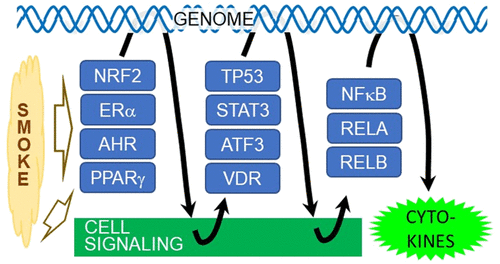当前位置:
X-MOL 学术
›
Chem. Res. Toxicol.
›
论文详情
Our official English website, www.x-mol.net, welcomes your feedback! (Note: you will need to create a separate account there.)
Stem Cell-Derived Endothelial Cell Model that Responds to Tobacco Smoke Like Primary Endothelial Cells.
Chemical Research in Toxicology ( IF 4.1 ) Pub Date : 2020-03-02 , DOI: 10.1021/acs.chemrestox.9b00363 Pei-Hsuan Chu 1 , Guibin Chen 2 , David Kuo 1 , John Braisted 1 , Ruili Huang 1 , Yuhong Wang 1 , Anton Simeonov 1 , Manfred Boehm 2 , David L Gerhold 1
Chemical Research in Toxicology ( IF 4.1 ) Pub Date : 2020-03-02 , DOI: 10.1021/acs.chemrestox.9b00363 Pei-Hsuan Chu 1 , Guibin Chen 2 , David Kuo 1 , John Braisted 1 , Ruili Huang 1 , Yuhong Wang 1 , Anton Simeonov 1 , Manfred Boehm 2 , David L Gerhold 1
Affiliation

|
To clarify how smoking leads to heart attack and stroke, we developed an endothelial cell model (iECs) generated from human induced Pluripotent Stem Cells (iPSC) and evaluated its responses to tobacco smoke. These iECs exhibited a uniform endothelial morphology, and expressed markers PECAM1/CD31, VWF/ von Willebrand Factor, and CDH5/VE-Cadherin. The iECs also exhibited tube formation and acetyl-LDL uptake comparable to primary endothelial cells (EC). RNA sequencing (RNA-Seq) revealed a robust correlation coefficient between iECs and EC (R = 0.76), whereas gene responses to smoke were qualitatively nearly identical between iECs and primary ECs (R = 0.86). Further analysis of transcriptional responses implicated 18 transcription factors in regulating responses to smoke treatment, and identified gene sets regulated by each transcription factor, including pathways for oxidative stress, DNA damage/repair, ER stress, apoptosis, and cell cycle arrest. Assays for 42 cytokines in HUVEC cells and iECs identified 23 cytokines that responded dynamically to cigarette smoke. These cytokines and cellular stress response pathways describe endothelial responses for lymphocyte attachment, activation of coagulation and complement, lymphocyte growth factors, and inflammation and fibrosis; EC-initiated events that collectively lead to atherosclerosis. Thus, these studies validate the iEC model and identify transcriptional response networks by which ECs respond to tobacco smoke. Our results systematically trace how ECs use these response networks to regulate genes and pathways, and finally cytokine signals to other cells, to initiate the diverse processes that lead to atherosclerosis and cardiovascular disease.
中文翻译:

干细胞衍生的内皮细胞模型可像原始内皮细胞一样对烟草烟雾做出反应。
为了阐明吸烟如何导致心脏病和中风,我们开发了一种由人类诱导的多能干细胞(iPSC)生成的内皮细胞模型(iEC),并评估了其对烟草烟雾的反应。这些iEC表现出统一的内皮形态,并表达标记PECAM1 / CD31,VWF / von Willebrand因子和CDH5 / VE-钙黏着蛋白。iEC还表现出与原代内皮细胞(EC)相当的管形成和乙酰LDL摄取。RNA测序(RNA-Seq)显示iEC与EC之间存在稳健的相关系数(R = 0.76),而iEC与初级EC之间对烟的基因反应在质量上几乎相同(R = 0.86)。对转录反应的进一步分析涉及18个转录因子在调节对烟雾治疗的反应中的作用,并确定了受每个转录因子调控的基因集,包括氧化应激,DNA损伤/修复,内质网应激,细胞凋亡和细胞周期停滞的途径。对HUVEC细胞和iEC中42种细胞因子的分析鉴定出了23种对香烟烟雾有动态反应的细胞因子。这些细胞因子和细胞应激反应途径描述了内皮细胞对淋巴细胞附着,凝血和补体激活,淋巴细胞生长因子以及炎症和纤维化的反应。EC引发的事件共同导致动脉粥样硬化。因此,这些研究验证了iEC模型并确定了EC响应烟草烟雾的转录反应网络。我们的研究结果系统地追踪了EC如何利用这些反应网络来调节基因和途径,最后向其他细胞发出细胞因子信号,
更新日期:2020-03-03
中文翻译:

干细胞衍生的内皮细胞模型可像原始内皮细胞一样对烟草烟雾做出反应。
为了阐明吸烟如何导致心脏病和中风,我们开发了一种由人类诱导的多能干细胞(iPSC)生成的内皮细胞模型(iEC),并评估了其对烟草烟雾的反应。这些iEC表现出统一的内皮形态,并表达标记PECAM1 / CD31,VWF / von Willebrand因子和CDH5 / VE-钙黏着蛋白。iEC还表现出与原代内皮细胞(EC)相当的管形成和乙酰LDL摄取。RNA测序(RNA-Seq)显示iEC与EC之间存在稳健的相关系数(R = 0.76),而iEC与初级EC之间对烟的基因反应在质量上几乎相同(R = 0.86)。对转录反应的进一步分析涉及18个转录因子在调节对烟雾治疗的反应中的作用,并确定了受每个转录因子调控的基因集,包括氧化应激,DNA损伤/修复,内质网应激,细胞凋亡和细胞周期停滞的途径。对HUVEC细胞和iEC中42种细胞因子的分析鉴定出了23种对香烟烟雾有动态反应的细胞因子。这些细胞因子和细胞应激反应途径描述了内皮细胞对淋巴细胞附着,凝血和补体激活,淋巴细胞生长因子以及炎症和纤维化的反应。EC引发的事件共同导致动脉粥样硬化。因此,这些研究验证了iEC模型并确定了EC响应烟草烟雾的转录反应网络。我们的研究结果系统地追踪了EC如何利用这些反应网络来调节基因和途径,最后向其他细胞发出细胞因子信号,



























 京公网安备 11010802027423号
京公网安备 11010802027423号